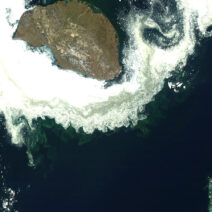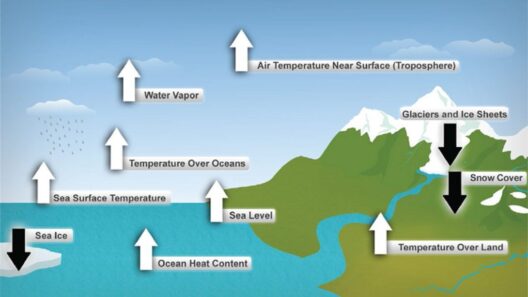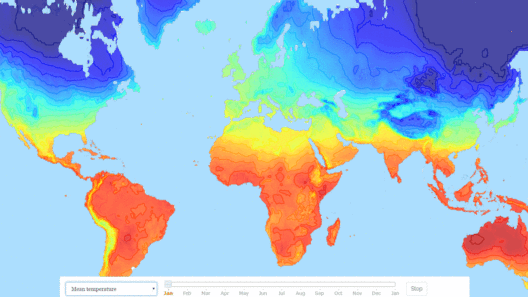The vast and diverse continent of Asia presents an extraordinary tapestry of climates, encompassing everything from tropical rainforests teeming with life to barren expanses of desert, and even the frigid tundras of the Arctic region. This unique climatic diversity is primarily influenced by geographic elements, oceanic currents, and altitude. Understanding Asia’s climate offers a glimpse into the grand interplay of nature, a subject that enthralls climatologists, environmentalists, and nature enthusiasts alike.
Beginning with the tropical regions, Southeast Asia serves as a veritable paradise, characterized by high rainfall and warm temperatures throughout the year. Countries such as Indonesia, Malaysia, and the Philippines experience a tropical climate classified as Af under the Köppen climate classification. This climate is marked by its ample precipitation, with monsoon seasons that dramatically affect agriculture, biodiversity, and the livelihoods of millions. The lush rainforests that thrive in these conditions are among the most biodiverse ecosystems on the planet. They serve as crucial carbon sinks, absorbing carbon dioxide and playing a pivotal role in mitigating climate change.
A notable feature of tropical climates is the presence of distinct wet and dry seasons, heavily influenced by monsoonal winds. In recent years, climate change has exacerbated the intensity and unpredictability of monsoon rains, leading to severe flooding and soil erosion, further impacting agricultural practices and biodiversity. The inexorable changes in climate patterns raise critical questions about sustainability and environmental stewardship in the face of increasing human encroachment on these vital natural resources.
As we transition from the tropics, we encounter the arid expanses of Central Asia, where deserts reign supreme. The Gobi Desert in Mongolia and parts of Kazakhstan and Turkmenistan exemplify the stark and often harsh climatic conditions of this region. These deserts fall under the BWh classification, indicated by their low precipitation rates, high temperatures, and extreme temperature variations between day and night. Life in these environments is resilient; species have adapted fascinating mechanisms for water conservation and thermal regulation. The camel, for example, remains an iconic symbol of survival in such unforgiving habitats.
The deserts of Asia illuminate the psychological allure of seemingly inhospitable landscapes. There is a compelling beauty in their vastness—an uncharted territory that invites exploration and introspection. Nevertheless, these arid regions are not devoid of ecological concerns. Issues such as desertification, exacerbated by climate change and unsustainable human practices, threaten not only local ecosystems but also global weather patterns. Understanding the delicate balance of arid environments is imperative as urbanization encroaches upon these pristine landscapes.
Further north lies the tundras of Siberia, characterized by their frigid temperatures and permafrost-covered terrain. The tundra biome, found primarily in the Arctic regions of Russia, features a unique climate that can be classified as ET, which denotes a polar climate. The long, harsh winters paired with short, cool summers result in a spectacular yet fragile ecosystem. This region teems with life, including migratory birds, reindeer, and various hardy plant species adapted to extreme conditions.
The tundra’s ecological significance is profound, serving as a vital carbon reservoir. Underneath the surface, vast amounts of methane and carbon dioxide are trapped in frozen permafrost. As global temperatures rise, the thawing of permafrost poses a dire threat; it may release significant amounts of greenhouse gases into the atmosphere, further accelerating climate change. The intricate web of life in the tundra reminds us of the precious interconnectivity of ecosystems, and serves as a stark warning of how climate disruption can have cascading effects.
The variation in climates across Asia allows for an extensive range of biodiversity, creating habitats rich in flora and fauna. Each biome offers complex ecosystems that provide services essential for human survival, including clean water, food, and natural resources. However, anthropogenic influences—such as deforestation, pollution, and climate change—pose substantial risks to these delicate environments. The transition from one climatic zone to another not only results in changes in biodiversity but also reflects cultural and social adaptations by human societies. Indigenous peoples, for example, have developed unique lifestyles and practices that are intrinsically linked to their surrounding environments.
Moreover, these climatic contrasts have significant implications for agriculture across the continent. Regions with temperate climates, such as parts of East Asia, benefit from four distinct seasons that allow for diverse crop cultivation. In contrast, the arid deserts necessitate innovative agricultural techniques, such as drip irrigation, to optimize water usage. Across Asia, farmers are increasingly adopting sustainable practices to combat the effects of climate change while striving to feed a growing population.
Asia provides a fascinating case study of climate variability and its profound impacts on human life and the environment. The interconnectedness of these climates illustrates the broader implications of local actions on global climate dynamics. Addressing challenges fueled by climate change necessitates a multidimensional approach; one that emphasizes conservation, sustainable development, and international cooperation. Only by understanding and respecting the remarkable diversity of Asia’s climates can we hope to preserve its invaluable ecosystems and ensure a sustainable future for generations to come.
In conclusion, the rich climatic spectrum of Asia—from tropical rainforests to barren deserts and frozen tundras—serves as a striking reminder of nature’s complexity. Each region fosters unique ecosystems that are not only beautiful but also crucial for our planet’s health. Examining how climate influences not only the environment but also human existence serves to deepen our fascination with, and commitment to, these precious landscapes.






